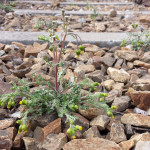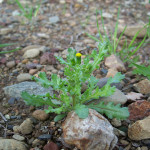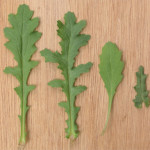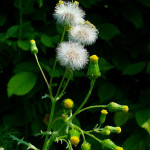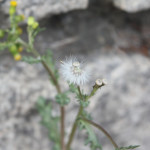Gallery:
- Senecio vulgaris plant habit, flower heads
- Senecio vulgaris flower bud
- Senecio vulgaris varied leaf shapes
- Senecio vulgaris seedling
- Senecio vulgaris seed heads
- Senecio vulgaris seed head
Common names:
Common groundsel, old-man-in-the-Spring
Scientific Name:
Senecio vulgaris
Description:
The plant is usually a winter annual, sometimes biennial, though it may germinate in all seasons. It grows from 4 to 18 inches tall. Flowerheads are numerous, with yellow disk flowers, but no ray flowers. The heads are cylindrical, 1/4 to 1/2 inch long, with black-tipped bracts around the base. Leaves are deeply lobed with toothed margins and may be smooth to hairy. They have little, or no, stalks and are alternately arranged on the stem. Basal leaves are usually purplish on the under surface, 1 to 4 inches long and 1/2 to 1-1/2 inches wide.
Life cycle:
Height of mature plants
Up to 3.5 feet
Flower color:
Yellow
Bloom time:
Throughout the year
Look-a-likes:
A similar species is woodland groundsel (Senecio sylvaticus). This plant generally is larger, growing up to 3 1/2 feet tall, with leaves more deeply lobed than those of common groundsel. Leaves are greenish gray and woolly. They are largest near the base of the plant, becoming increasingly smaller toward the top. The plant has a nauseating odor when bruised. Woodland groundsel more often is found along roads and in disturbed areas in the forest, while common groundsel is a weed of fields and gardens and the waste areas nearby.
Habitat:
This weed is found in many crops including forages, cereals, mint, berries, and row crops, as well as in ornamentals and vegetable gardens.
Impacts:
Common groundsel is a problem weed in cultivated crops, gardens and nurseries. It is poisonous to cattle and horses and toxic to humans. It contains pyrrolizidine alkaloids, which can cause irreversible liver damage and possibly death.
Noxious Weed Listing:
- WeedWise: Maintenance
- State of Oregon: Not listed
- State of Washington: Class C
- Four County CWMA: Class D
Origin:
Europe, Asia and Northern Africa
Links:
Washington Noxious Weed Profile
Invasive.org profile
CABI Invasive Species Compendium

